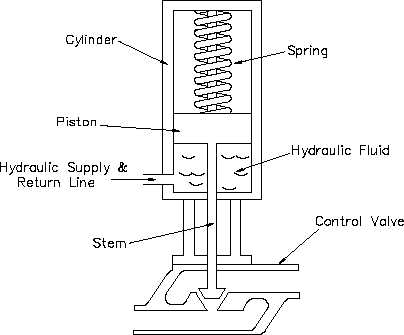Process Controls
VALVE ACTUATORS
Hydraulic Actuators
Pneumatic actuators are normally used to control processes requiring quick and accurate response,
as they do not require a large amount of motive force. However, when a large amount of force
is required to operate a valve (for example, the main steam system valves), hydraulic actuators
are normally used. Although hydraulic actuators come in many designs, piston types are most
common.
A
typical
piston-type
Figure 37 Hydraulic Actuator
hydraulic actuator is shown
in Figure 37. It consists of
a cylinder, piston, spring,
hydraulic supply and return
line, and stem. The piston
slides vertically inside the
cylinder and separates the
c y l i n d e r
i n t o
t w o
chambers.
The upper
chamber
contains
the
spring
and
the
lower
chamber contains hydraulic
oil.
The hydraulic supply and
return line is connected to
the lower chamber and
allows hydraulic fluid to
flow to and from the lower
chamber of the actuator.
The stem transmits the
motion of the piston to a
valve.
Initially, with no hydraulic fluid pressure, the spring force holds the valve in the closed position.
As fluid enters the lower chamber, pressure in the chamber increases. This pressure results in
a force on the bottom of the piston opposite to the force caused by the spring. When the
hydraulic force is greater than the spring force, the piston begins to move upward, the spring
compresses, and the valve begins to open. As the hydraulic pressure increases, the valve
continues to open. Conversely, as hydraulic oil is drained from the cylinder, the hydraulic force
becomes less than the spring force, the piston moves downward, and the valve closes. By
regulating amount of oil supplied or drained from the actuator, the valve can be positioned
between fully open and fully closed.
Rev. 0
Page 57
IC-07


